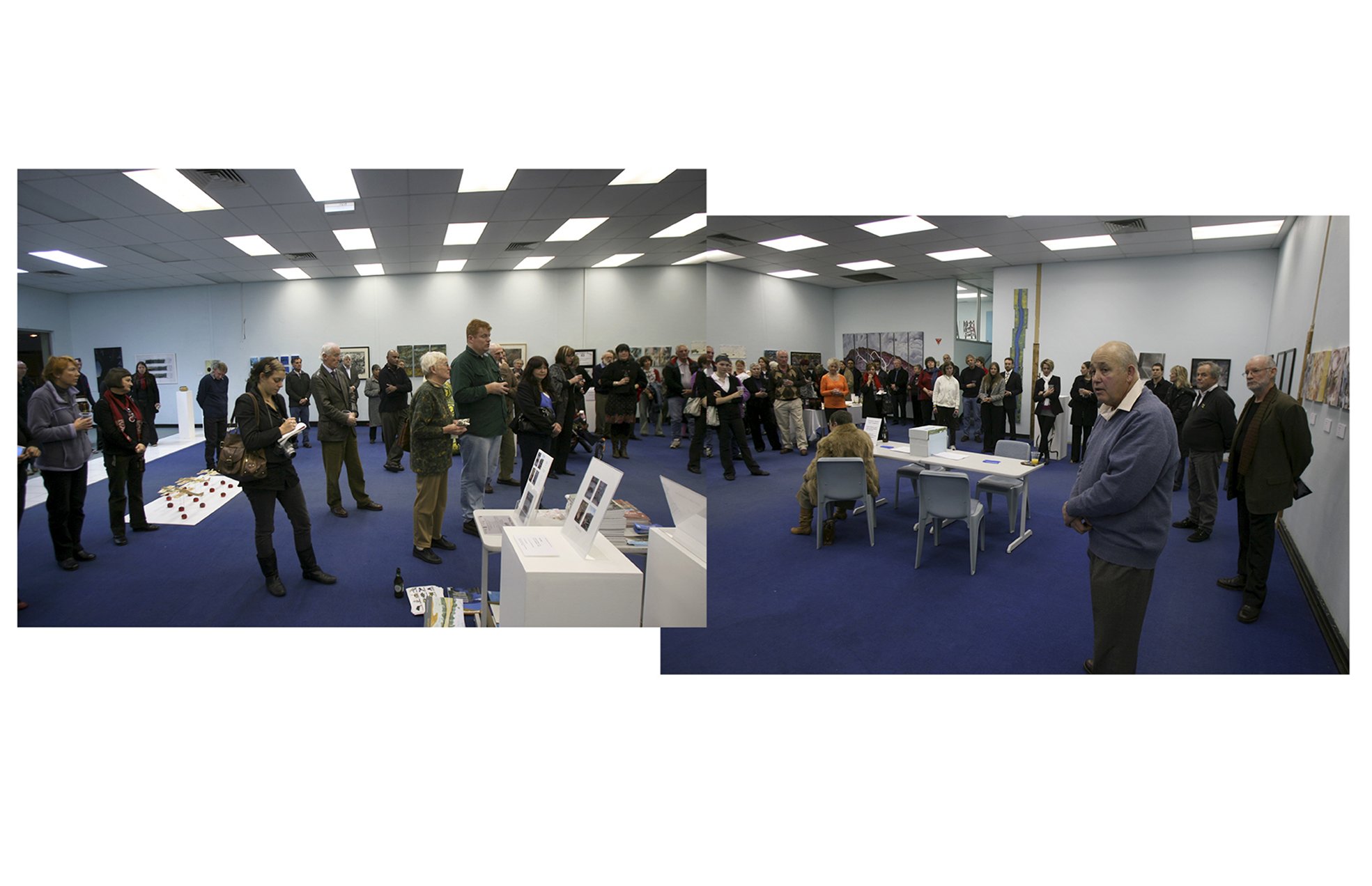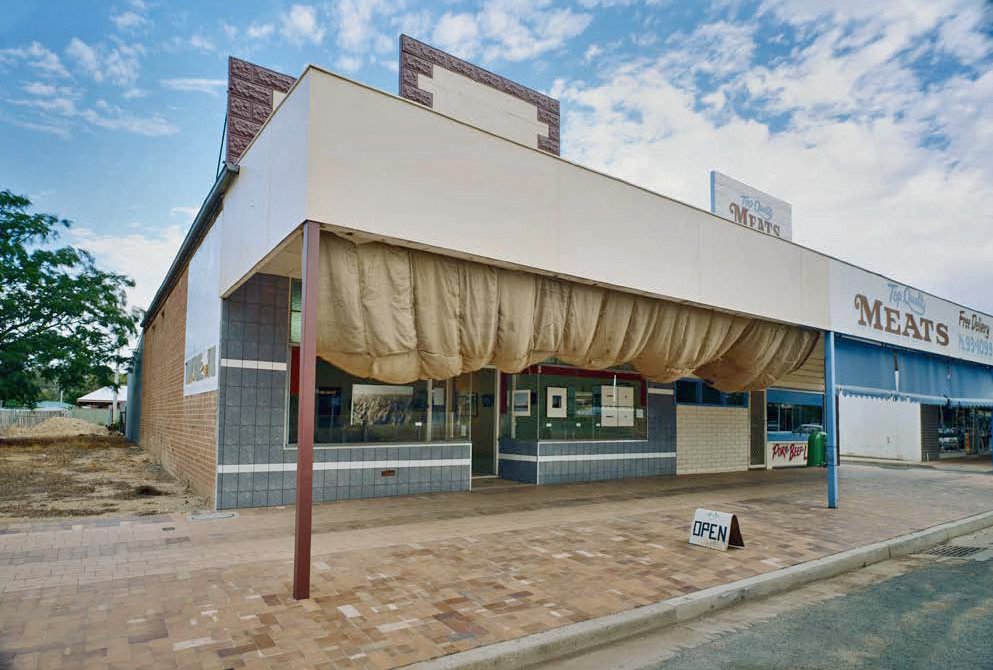Engaging Visions Research Project
2007 - 2010
Opening night, Engaging Visions Research Project exhibition Tumut: An exhibition of Visual Art, ex-State Bank Building, Wynward Street, Tumut, August, 2008. Cr Gene Vanzella, Mayor of Tumut Shire Council (right foreground), addresses the crowd. The exhibition also included works produced by artists from the Tumut Campus, Riverina Institute, TAFE, who undertook projects that addressed environmental themes in concert with the Tumut Field Study. Local environmental groups erected displays in the gallery to promote their activities and to recruit new members.
Tumut Field Study 2008. Photograph: Dean Sewell
The Background to, and Scope of, the EV Research Project
The programs and partnerships that lead to the creation of the Engaging Visions Research Project (EV Research Project) has a history and depth of interaction far beyond the scope of the three-year research enterprise – 2007-2010.
In 1996, John Reid initiated the first Field Studies program at the School of Art (SoA) at The Australian National University (ANU). Field Studies programs offered students a unique opportunity to take their art practice beyond the artist studio ‘into the field’ where sustained research opportunities combine quality sensory, intellectual and reflective experiences to inspire the production of fine art.
A typical Field Studies program takes art students into the same field location two or three times over the course of an academic semester. During these trips, students are briefed by a range of people within the community – local scientists, indigenous leaders, shire officials, community leaders and activists, and local artists – about matters of significance to their region. In the last decade, these briefings have frequently focused on critical environmental issues confronting small rural communities in the Murray Darling Basin (MDB). Students participating in the programs are encouraged to create art, both in the field and back in the studio, as inspired by their interactions with the people and the places they visit. Soon after the final field trip, the artworks created are formally exhibited back in the field community, usually in an unoccupied retail space in the main street.
Vacant fruit shop, Lachlan Street, Hay, was the temporary gallery for the Murrumbidgee and the Hay Plains Field Study exhibition. Murrumbidgee on the Hay Plains Field Study 1997. Photograph: John Reid
Vacant premises in main streets make excellent exhibition venues for reaching community who don’t normally frequent established visual art galleries, especially when exhibitions coincide with community festivals. The vacant shop/main street venues in Grenfell, NSW, in 2003, for the Henry Lawson Festival, attracted 900 visitors in 5 days; and in Gunnedah, NSW, in 2004, for the Two Rivers Festival, attracted 500 visitors in 4 days.
In 2001, Field Studies attracted the interest and the buy-in of the then Murray-Darling Basin Commission (MDBC, now Murray-Darling Basin Authority), who agreed to support Field Studies programs as part of its integrated catchment program to improve the environment of the MDB. This partnership developed with the Field Studies programs that took place in river catchments in the Basin between 1997 and 2000. It profoundly influenced, motivated and inspired many student participants to address environmental issues.
Art school students were always the main focus for Field Studies, however, the effects and influences of their repeat visits to small communities in the MDB proved to have significant impacts. Of particular note, across the 12 Basin field locations that had been visited up to 2006, were the award-winning education benefits to students, and the frequent remarks by community members about how the artworks produced helped them see their own ‘backyards’ with fresh eyes.
In 2006, John Reid teamed-up with Lawrie Kirk of the MDBC and Rod Lamberts of the Centre for Public Awareness of Science at the ANU to seek funds to formerly evaluate, for the first time, what effects Field Studies programs had not only on participating SoA students and graduates, but on the communities they visited as well. This was the beginning of the Engaging Visions Research Project (EV Research Project).
At the end of 2006, with a major contribution from Lawrie Kirk, MDBC Communication Manager and prospective Partner Investigator, the EV Research Project won a Linkage grant from The Australian Research Council to progressively evaluate the effects of Field Studies programs in four sites along the MDB - one in each of QLD, NSW, VIC and SA. The overall goal was to ‘Configure a model for visual artists to assist catchment communities in addressing natural resource management issues’. In addition, the results of the EV Research Project were intended to inform a joint ANU - MDBA 10 year Engaging Visions Investment Plan for cultural practitioner and community engagement to increase the uptake of sustainable practices in the MDB.
As the EV Research Project unfolded, so too the scope expanded such that the final results offer ideas, advice and guidance not only to help artists best interact with communities, but also communities with artists. Consequently, twenty five recommendations emerged from the Project.
In talking to, and working with, artists and community members, cultivating a presence across a range of local and national media and, critically, capturing the experiences and opinions of community members who visited the final exhibitions, the EV Research Project has produced fine art works, exhibitions and catalogues; contributed to community sense of place; developed a practical guide for engaging visual artists in environment dialogues with rural communities; and devised an Engaging Visions Investment Plan, incorporating an Engaging Visions Agency, to support long-term initiatives that arise from Field Study programs in the MDB.
A book, Engaging Visions: Engaging Artists with the Community about the Environment, represents an encapsulation and visual documentary of the EV Research Project across the four case study sites: St George, QLD; Tumut, NSW; the Riverland SA; and Benalla, VIC. In there you will find artworks inspired by each site, documentary photographs of the people, places and processes of the EV Research Project, as well as an overview of the research methods and their results. A greatly enhanced procedure for engaging artists with Basin catchment communities has been modeled.
The model procedure, Field Studies version 2 (Field Studies v2) will significantly improve the interaction and engagement of tertiary art students with field research in the MDB.
The model procedure also has applications that go well beyond the tertiary art educational setting that initiated the traditional Field Studies program. The improved procedure for artist/community engagement has been adapted by secondary education institutions and community art organisations.
Note: The conclusion of the EV Research Project in 2010 coincided with crippling political demands on the MDBA for a Murray/Darling Basin Plan. As a consequence, resources were not available for the implementation of the Engaging Visions Investment Plan, with its Engaging Visions Agency, to support the long-term initiatives that were envisaged.
Above Front and back of the Engaging Visions Guide
The Engaging Visions Book - Front and back cover. Published in 2010 by The Australian National University.
National Library of Australia Cataloguing-in-Publication entry Title: Engaging visions : engaging artists with the community about the environment / John Reid ...[et al.]; photographs by Dean Sewell [et al.] Edition:1st ed. ISBN: 9780646536279 (pbk.) Subjects: Australian National University. Murray-Darling Basin Authority (Australia). Environmental protection--Darling River Watershed (Qld. and N.S.W.) Artists and community. Darling River Watershed (Qld. and N.S.W.) --Environmental aspects. Other Authors/Contributors: Reid, John. Sewell, Dean, 1971-. Hilliker, Clive. Dewey Number: 363.700994







